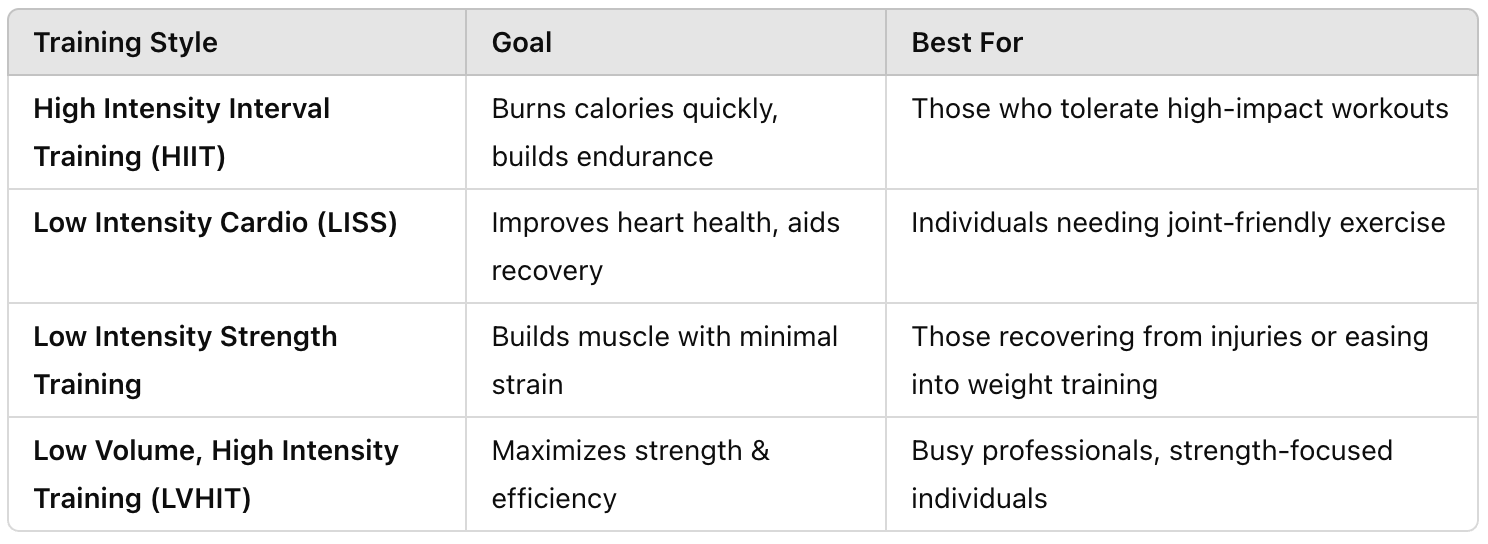The Power of Low Volume High Intensity Training (LVHIT) to Build Strength & Longevity
As we age, our approach to fitness needs to evolve. The high-impact, exhaustive workouts of our 20s and 30s may no longer serve us as effectively. But that doesn’t mean we can’t train hard or see results. Consider low volume, high intensity training (LVHIT)—an approach designed to maximize strength, longevity, and functional fitness without excessive wear and tear on your body.
If you’re a busy professional in your 40s or 50s looking to stay strong, fit, and injury-free, this training style could be your answer. Let’s break it down.
What is Low Volume, High Intensity Training (LVHIT)?
LVHIT is a strength training method that emphasizes fewer sets and reps, but with heavier resistance and maximum effort. Unlike traditional high-volume workouts that require multiple sets and extended gym time, LVHIT delivers powerful results in short, focused sessions.
Benefits of LVHIT for Gen X:
✔ Maximizes Muscle Growth & Strength – Lifting heavier for fewer reps stimulates muscle fibers without excessive fatigue.
✔ Saves Time – No need for long gym sessions; each workout is efficient and effective.
✔ Protects Your Joints – Less repetitive strain compared to high-rep training, reducing injury risk.
✔ Boosts Metabolism – High-effort lifts increase post-workout calorie burn, supporting fat loss.
How Does LVHIT Compare to Other Training Styles?
Many people in Generation X wonder: Should I focus on high-intensity interval training (HIIT) or low-intensity cardio? Or Is low-intensity strength training a better option? Here’s how they compare:
LVHIT combines the best of both worlds—strength and efficiency—making it a top choice for Generation X professionals who want to stay fit without spending hours in the gym.
How to Incorporate Low Volume, High Intensity Training into Your Routine
If you're ready to build strength without burnout, here’s how you can structure an LVHIT session:
1. Focus on Compound Movements
Exercises like squats, deadlifts, bench presses, and pull-ups activate multiple muscle groups and maximize results.
2. Lift Heavy with Fewer Reps
Aim for 3-5 sets of 4-6 reps at 80-90% of your max weight. This stimulates muscle growth without excessive volume.
3. Prioritize Rest & Recovery
Take 1-2 minutes between sets to allow full recovery and maintain intensity. LVHIT is about quality over quantity.
4. Incorporate Low Intensity Strength Training
On off days, incorporate low intensity weight training—lighter resistance exercises that promote mobility, recovery, and joint health.
5. Mix in Low Intensity Interval Training (LIIT)
Unlike HIIT, LIIT focuses on controlled, steady movements with short rest periods, offering a great alternative for endurance and fat loss without excessive stress on the body.
Conclusion
Your workouts don’t need to be long to be effective. Low volume, high intensity training is a game-changer for busy professionals looking to build strength, stay fit, and maintain longevity. By training smart, prioritizing recovery, and working with a knowledgeable coach, you can achieve results without unnecessary strain or time commitment.
Train Smarter with a Virtual Coach
If you’re tired of generic workout programs that don’t account for your body’s unique needs, it’s time to train smarter. My virtual personal training services will help you:
Get a CUSTOMIZED Plan
1-1 Virtual Training
1-1 Health Coaching
All with a REAL Coach
COACH DEE
Online Personal Trainer CPT: ACE & Trauma Informed Weight-lifting
About the Author: Coach Dee
Deborah Park, known as Coach Dee, is the owner of Drip Training LLC and an ACE Certified Personal Trainer and Health Coach. With a background in architecture and kinesiology from the University of Virginia, she has extensive experience in personal training and athletic coaching in a clinical (physical therapy) setting. Coach Dee combines her scientific knowledge with years of hands-on experience and generational knowledge of food as medicine to create programs that empower clients to regain control over their bodies and minds.
Her journey into personal training was deeply influenced by her personal struggles, including recovering from a life-changing car accident that led to PTSD and pain from scoliosis. This experience gave her a unique understanding of the connection between mental health and physical well-being. Coach Dee is committed to helping clients develop resilience, build strength, and rediscover their confidence—no matter the challenges they face.


